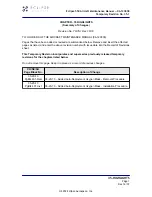
FES Propeller Manual Version 1.0
February 2013
Page 7 of 9
Fig.1 Propeller blades mounting on the holder
4.6 Tighten the spinner p.4 with special M4 Inox bolts p.3.
4.7 Removal - refer to 4.1 through 4.6 but in reverse order. In any case, if hard tools
are used, the propeller will be damaged.
6. Inspection
5.1 Every time you go to fly, thoroughly perform preflight inspection:
- take a look at the entire propeller inspecting for damages, leading and trailing
edges for possible splitting or de-lamination.
- composite propeller blades are always as good as they look. If the total blade
surface show no cracks, no reconditioning or overhaul will be necessary. Pay special
attention to the root part of the blade, leading and trailing edges.
- inspect central part of the propeller for possible cracks or deformations. No cracks
or deformations are allowed. If such are found, contact the manufacturer.
5.2 At the 25 hours inspection (periodically to be done up to the annual inspection):
- clean the propeller with any car wash solution or equivalent.
- make the normal preflight inspection, but especially pay attention to the center part
of the propeller, leading and trailing edges of the blades for cracks and de-laminations and
the lacquer surface for condition.
- inspect blades for stone damages, and mark them.
5.3 Annual inspection or inspection after up to 15 % over-speed of the rated
maximum rotational speed RPM:
























